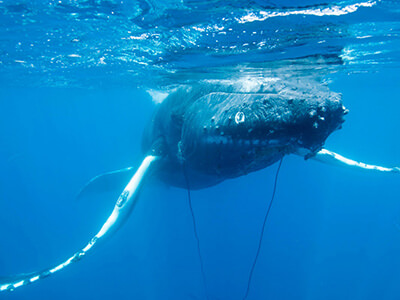Whale Disentanglement Training

Photo: Ed Lyman/NOAA, under NOAA permit #14682
Did you know that whale entanglement is a significant issue impacting marine wildlife, particularly large baleen whales? When entangled whales are spotted, response teams use specialized equipment to attempt to free them. This can be dangerous for both the whale and the rescuers, which is why education and proper training are so important.
Whale entanglement occurs when whales become ensnared in fishing gear, such as nets, lines, or traps, which can restrict their movement, cause injury, or even lead to death. The primary cause of entanglement is human activity, particularly commercial and recreational fishing. Gear such as gillnets, crab traps, and lobster pots can inadvertently ensnare whales as they move through their habitat.

A humpback whale entangled in cable. Photo: E. Lyman/NOAA, under MMHSRP Permit #18786-02
Various whale species are at risk, but large baleen whales like the North Atlantic right whale, humpback whale, and gray whale are particularly vulnerable due to their size and feeding habits. Entangled whales can suffer from physical injuries, including deep lacerations, reduced mobility, and infections. The stress of entanglement can also lead to behavioral changes, malnutrition, and decreased reproductive success.
Efforts to reduce entanglement include modifying fishing gear, implementing seasonal fishing closures, and using technology like acoustic monitoring to detect and avoid whale presence. Many regions have established regulations to minimize whale entanglement risks, including gear restrictions and reporting requirements for entangled whales.

Captain Zodiac disentanglement training permitted and done in coordination with NOAA Fisheries working under the Marine Mammal Heath and Stranding Response Program (Permit# 24359)
This past week Captain Zodiac assisted with the Hawaiian Islands Humpback Whale National Marine Sanctuary’s (Sanctuary) Whale Entanglement Response training. Below are some details:
Maria Harvey (Harvey), the Sanctuary’s Large Whale Rescue, Resource Protection, and Monitoring Assistant flew over to provide crucial training to a team of volunteer community members. Under Harvey’s guidance, we were able to understand that safety is the top priority when working around large marine mammals and the inherit risks that go along with disentanglement. The team worked with two Captain Zodiac rafts, one towing an entangled whale tail while the other acted as a support vessel. On the small NOAA inflatable Harvey talked each 3 person team through the process before each team were given the opportunity to perform each task. To begin we practiced kegging, which helps slow the whales down to allow for lines to be cut at a hopefully slower speed. Then we worked on deploying a flying knife from a telescoping pole to cut lines from the whale tail. Lastly, we used a cutting grapple to throw on lines, which can be used on trailing gear or lines wrapped around the body of the whales.

Captain Zodiac disentanglement training permitted and done in coordination with NOAA Fisheries working under the Marine Mammal Heath and Stranding Response Program (Permit# 24359)
This training allows for an on island team to be prepared to deploy to help assist a whale in trouble alongside Sanctuary staff – Maria Harvey (Level 4) or Ed Lyman (Level 5). Ed Lyman is the regional large whale entanglement coordinator and has been leading the Hawaii network since its creation over 20 years ago.
All disentanglement activities are permitted and done in coordination with NOAA Fisheries working under the Marine Mammal Heath and Stranding Response Program (Permit# 24359)
If you see a whale in distress, do not intervene, please call 888-256-9840 (Option 3). To learn more about the Hawaiian Islands Humpback Whale National Marine Sanctuary, visit https://hawaiihumpbackwhale.noaa.gov/
